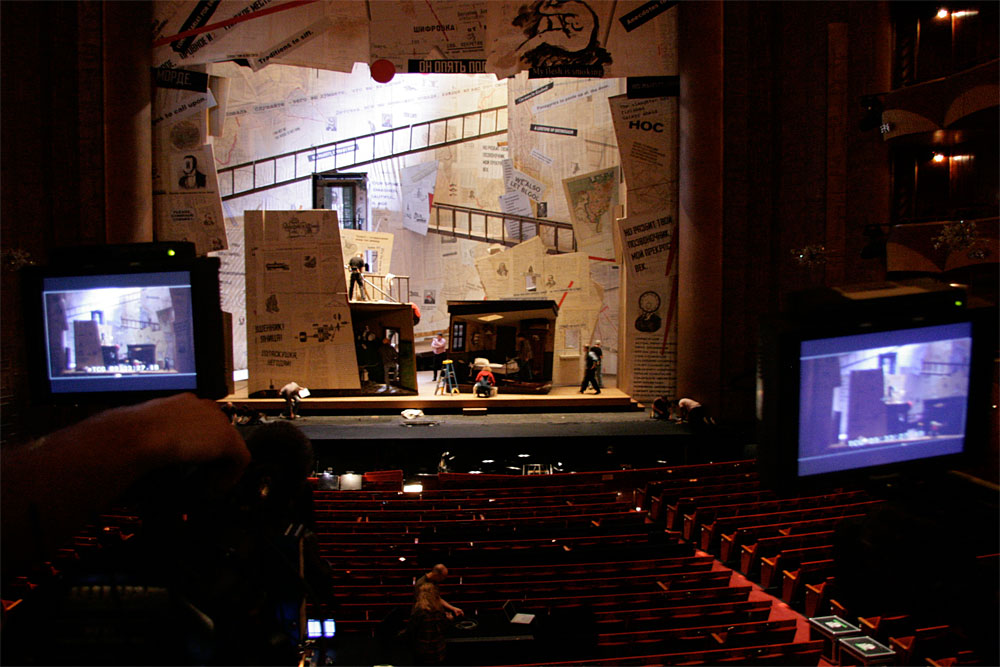
View of the Met stage from the parterre level, The Metropolitan Opera, New York. Photo by Ian Forster.
The leaders of Art21’s Production Department, Eve Moros Ortega and Nick Ravich, sat down for a casual conversation about the production of William Kentridge: Anything Is Possible. Their discussion sheds light on the challenges faced by Art21 in creating its first one-hour film about a single artist, as well as the rewards of working with the dynamic and multi-talented William Kentridge. With filming locations as complicated as The Metropolitan Opera and artwork that has many iterations, telling the story of Kentridge’s working process and sources of inspiration pushed the production team to new creative and technical heights.
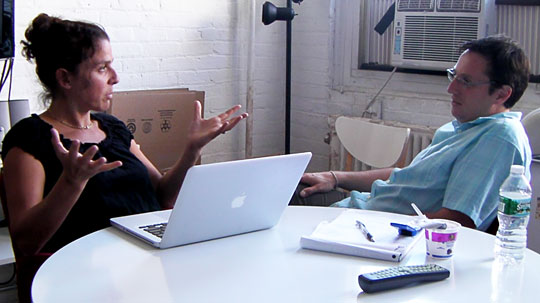
Eve Moros Ortega, managing director, and Nick Ravich, director of production, at the Art21 offices in New York City. Photo by Ian Forster
NICK RAVICH: Hi Eve, how are you doing?
EVE MOROS ORTEGA: Good, Nick, how are you?
NR: I’m doing well. Do you want to introduce yourself?
EMO: I’m Eve Moros Ortega and I’m the Managing Director of Art21 and the Series Producer of the Art in the Twenty-First Century series. And I’m also Co-Producer of William Kentridge: Anything Is Possible.
NR: I’m curious about your role as Series Producer. Why don’t you explain a little bit more?
EMO: Well, I’ve been with Art21 since the beginning. My role is to make sure that the series is produced on time and budget, and to be the joint between many different pieces of the process — from working very closely with you, Nick, in the post-production, to talking with Susan [Sollins, Executive Producer, Director, and Curator] and Wesley [Miller, Associate Curator] about curatorial issues, and then getting the film out there with proper station relations and publicity.
NR: And I’m Nick Ravich, Director of Production. My role at Art21 for William Kentridge: Anything Is Possible generally involved lots of shoot scheduling, making sure we have the gear that we need for any particular shoot, as well as some bigger picture stuff, like figuring out what camera we use for the entire film.
EMO: Recently, we were talking about Killer Films and because I used to work in independent features, I remember somebody asking Christine Vachon, “what is a producer?” And I think her answer was something like, “you do whatever it takes to get it done.” Since I’ve been here since the beginning and I’ve worn different hats, sometimes I was more involved in fundraising or sometimes I go on the shoots. So I also think that the definition is elastic. As you know, for William Kentridge: Anything Is Possible, I was much more on the ground, hands-on…
NR: Yes.
EMO: So: going in the trenches versus throwing supplies into the trenches from on high. It really varies depending on the project and what the needs are. One of the things that I really enjoy about producing out of a place like Art21 is that very flexibility and elasticity of what a producer does. It was really something that drew me to documentary. Did you ever do features also?
NR: Not really.
EMO: It’s just really different, because it’s so much bigger. Maybe some of that might have changed because now some features are being filmed on video with much smaller crews. But there’s still this infrastructure to making a feature. You have the production process itself as all these departments. So you have your art department, props, wardrobe, hair and make-up, etc. Then you have the gaffers (electrical department), the grips, the camera department, and craft service. You just have a much bigger group of people. As a result, as a producer, you have a much more tightly defined role. I’ve put makeup on our interview subjects or helped carry equipment or conducted the interviews — whatever it takes. Whereas, feature films have a much more narrow definition of producing.
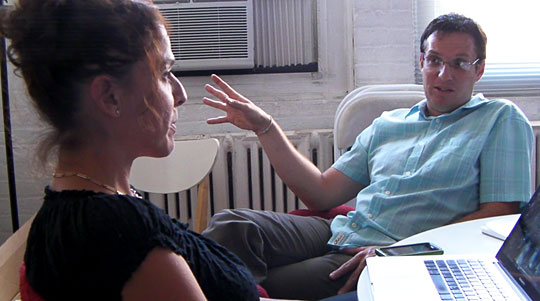
Eve Moros Ortega, managing director, and Nick Ravich, director of production, at the Art21 offices in New York City. Photo by Ian Forster.
NR: Let’s talk about the genesis of William Kentridge: Anything Is Possible. William was one of our featured artists in Season 5 of Art in the Twenty-First Century. At a certain point along the way, Susan Sollins thought, “hey, this could be longer and bigger.”
EMO: One thing that’s also very interesting about Art21 is that we don’t position ourselves as a production company. We’re very much a nonprofit organization. That impacts how we do things. For example, I don’t think production companies are in the habit of doing strategic planning the way nonprofit organizations do. In 2006, we underwent a pretty comprehensive strategic planning process for our organization. We came up with a sort of three-to-five year plan for where we wanted to be. One of the outcomes of that was that we really wanted to make a film during the year that we’re not releasing one of our biennial new seasons of the series. So that’s where the goal really first emerged.
NR: So, why Kentridge?
EMO: There was already a cognizance that it would be a challenge to expand from the series format of the 15-minute segment per artist, to an hour on one artist. What was appealing about Kentridge was not only was there a depth to his story, but there were a lot of components to the content of what he was doing. He was touching upon so many different areas of content really — from the Russian revolution, to Jews in South Africa, to apartheid, to early cinema.
NR: Not just that. There were many opportunities to shoot.
EMO: Right, so there was a richness to the content that felt ripe for mining. The timing was good, in terms of the fact that there were these opportunities. In terms of telling a dramatic, entertaining story, there was a lot going on with his work — mainly, of course, his production of The Nose for The Metropolitan Opera. There are a lot of artists who were wonderful, but they were primarily studio-based.
NR: We didn’t have the same opportunities with them.
EMO: Yes. There are some artists who are just primarily working in their studio — maybe on the computer, maybe with assistants — and whether that would be interesting for an hour, it’s a much more challenging assignment.
NR: So important lesson here for potential Season 6 artists? Make an opera.
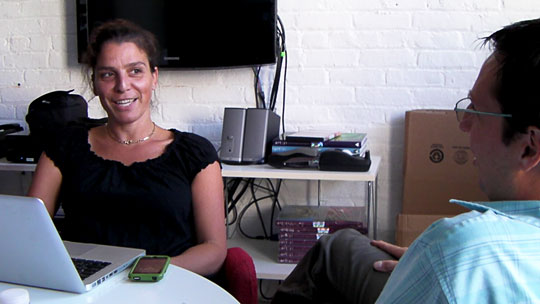
Eve Moros Ortega, managing director, and Nick Ravich, director of production, at the Art21 offices in New York City. Photo by Ian Forster.
EMO: You know Nick, I got something out of one of your blog posts, which is when you interviewed Thom Powers from Stranger Than Fiction. Because now, of course, we’re starting to think about what can we do next. A takeaway from that post you did was when he was saying that the best art films aren’t really about the art; they’re about something else. So if it’s just spending an hour with an artist as he/she just creates work unto itself, that might start to feel long. But if there’s something more going on and we have the opportunity to, for example, film at The Metropolitan Opera, then it’s something very unusual for us.
NR: Definitely the most time that you probably spent on any particular part of this production process was clearing the way for us shooting at the Met. So let’s talk a little bit about that.
EMO: You know, they’re a very august institution. We were very lucky in part to have the way paved by some very helpful advocates there. I think our reputation preceded us and that made a really big difference. Once we got over the hump of how we were going to work together and what the parameters were going to be, then we could focus more on, okay, this is great, we’ve established permission to go into this incredibly complicated place. And it is incredibly complicated. That, to me, was one of the most fascinating parts of working on this — getting that behind-the-scenes view of just how complicated it is.
NR: One of the things that attracts me — and I know this is true of really large cultural institutions, but particularly operas — is that they are planning and staging several years out from the final performance. So we started shooting at the Met in August of 2009. We started in the scene shop; they had a fall rehearsal process that we covered. Then they waited basically half a year because they had so much else going on. We came back to shoot the continuation of that building up to the full dress rehearsals. So one of the things that I’m guessing folks probably don’t know it that this was our first live multi-camera shoot. Live in the sense that we’re covering a live performance, that we couldn’t say, “hey, do you mind stopping and doing that over again?” We weren’t broadcasting it live. I certainly remember that time in the spring well.
EMO: Doing that kind of a shoot at The Metropolitan Opera is really a baptism by fire. We had actually had two-camera shoots before — with Laylah Ali, for example. But the stakes were a lot lower and it was a really small venue with only two cameras.
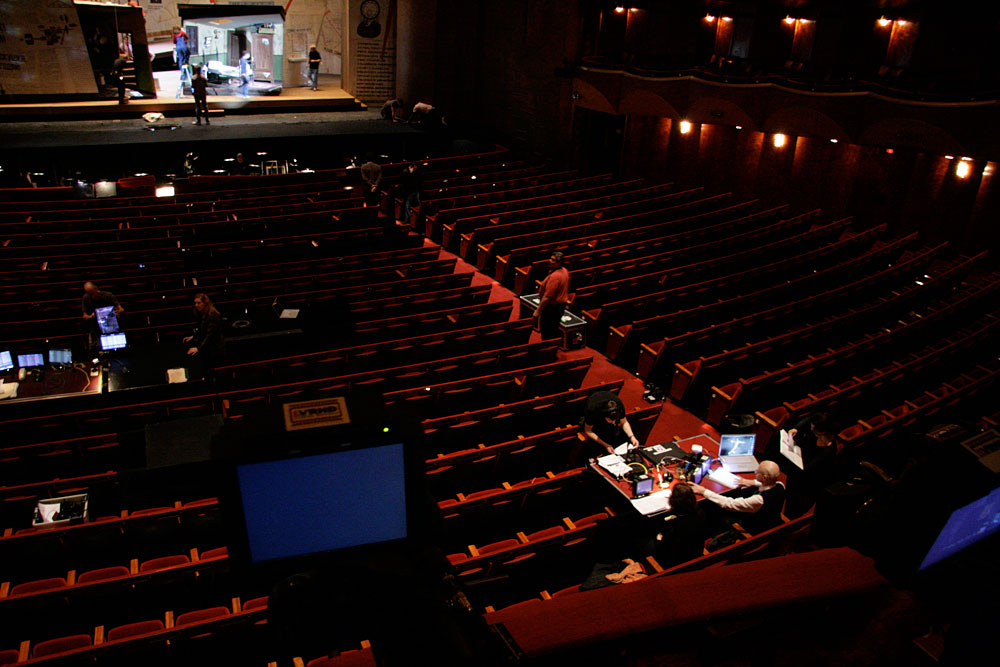
View of the Art21 production table from the parterre level, The Metropolitan Opera, New York. Photo by Ian Forster.
NR: Give people a sense of the geography of the Met auditorium.
EMO: It required really negotiating where those three cameras would go. The challenge was how to mesh our needs, which had to do with having a good view of the stage, having sufficiently different angles towards the stage for the three different cameras, and having positions that would allow the three cameras to cut well together. For us to meet those criteria, while also meeting the Met’s needs (which had to do with making sure we weren’t taking up valuable real estate at the performance and weren’t jeopardizing them legally with being right in the middle of things — in the aisles, for example), made the negotiation a challenging one.
There were some surprises at the end. For example, we wanted to be sure that our camera positions had space around each camera person to insure that they weren’t going to have interference from spectators. We literally found out, I think just a few days before, that not only did they make the final dress rehearsal public — which is not something we knew in advance — but additionally, they were opening it up to very young schoolchildren. A big gaggle of them were positioned right next to one of our main camera people, who initially was quite worried that this giant group of five year-olds would be fidgety and thus jiggling the seats that would in turn affect his camera. But luckily that didn’t happen. So we got over the hurdle of getting our camera positions. Then we had to figure out how to communicate with each other because the camera positions were far from where the directors were stationed.
The directors needed to be in the orchestra and they themselves needed to negotiate where they were going to be because they needed to have access to power, monitors to see what the camera people were doing, and lights to see their notes about their pre-performance ideas of what the camera people were going to film. These positions were all pretty far from each other. We had the directors in the center orchestra. We had one of the cameras way, way in the back of the orchestra. And we had two cameras in the parterre level.
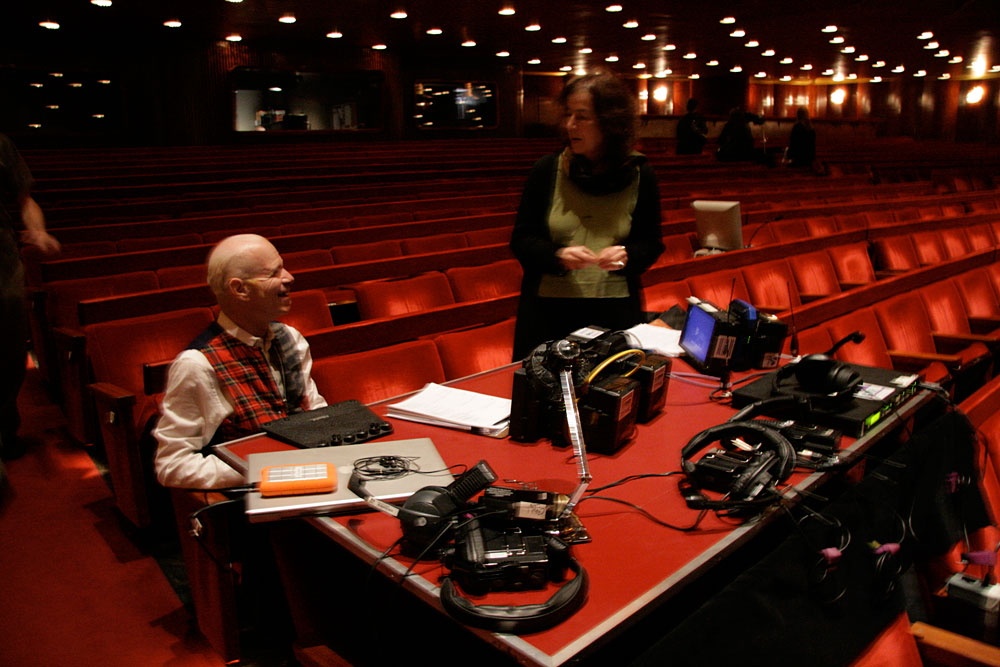
Directors Susan Sollins and Charles Atlas at the production table, center orchestra, The Metropolitan Opera, New York. Photo by Ian Forster.
NR: Right next to each other. You know, ironically, that led to the sort of biggest crisis of that shoot day; it wasn’t video and we were actually sending the video feeds from the camera (wirelessly via HD) to the directors. It wasn’t the performance audio, which we were actually getting a clean feed out on that board. It was actually our own internal communication, which no one would ever hear, that caused the crisis.
EMO: Right, right. It was funny because this was so new for us; we were very thorough about all the planning. It was just ironic that this one detail tripped us up, and it was mainly having to do with the incredible complexity of wireless frequencies at the Met. The Met is probably one of the hardest spots in the entire world to deal with wireless frequencies because there’s so much competition in that one very congested spot of Lincoln Center for all the wireless frequencies. One frequency would be to feed the audio from our audio recorder who was connected to the Met soundboard, because we could never do a better job of getting the sound than they could. That frequency was to feed that audio to the three remote cameras.
NR: Right, as a kind of scratch track.
EMO: Right. The other frequency was for us to all talk to each other. So the system whereby we were all talking to each other was through wireless headsets and there were basically five units per set. We needed them all because we were a big crew. We found out very soon before the performance that it didn’t quite work. It took tremendous cool on the part of our audio assistant to push through and get at least the one set to work. We all had to come together and figure out what do we do about the other set? Do we try to run back to the vendor and get one that would work, or do we just make do? We wound up making do by text messaging each other. I think it was a lesson that maybe next time, that will be the thing to be even more vigilant about.
NR: Yeah, you thought it was covered.
EMO: It could just be human error. It’s like we were told one thing and it turned out not to be accurate or there was a miscommunication. I think production by its nature is prone to that. That’s why it’s good to have a super, top-notch crew and to be able to be flexible. It was a real growing experience for Art21 to learn how to do that.
NR: So one of the challenges that was specific to William Kentridge: Anything Is Possible outside of the Met, in terms of the production that popped up late in our online editing process, was Kentridge’s films. Our film relies pretty heavily, I would say — 15% to 20% of the film itself actually — on Kentridge’s own, beautiful animations. William’s aesthetic is very rough-hewn and that gives it a lot of its charm, and there’s a very willful non-conformity to it all. We actually got very, very late in the editing process when we noticed something that’s arguably a “mistake.” What happens in this process is that for the off-line edit, we use a DVD copy. So that’s not quite ready for primetime, not ready for broadcast. I think this was one of the Méliès films…
EMO: Feats of Prestidigitation (2003).
NR: There we go. There’s a point at which he’s sort of riffing and drawing. Since the get-go, he seemed to do it in a sort of stuttering motion. We thought, “of course, that’s William’s video.” Then, for whatever reason, we check really late in the game and oh my gosh, that’s not right and that’s not what’s on the master.
Excerpt from William Kentridge: Anything Is Possible, 2010
Installation footage of 7 Fragments for Georges Méliès (via YouTube user mauvaispas)
EMO: Like you say, this is a big challenge, especially because Kentridge himself has this iterative process. What is very much embedded in his work is this notion of seeing the imperfections, seeing the process within the work.
NR: Yes.
EMO: And it’s intentional. Laylah Ali, for example is so fastidious about making sure you don’t see that, whereas with Kentridge, it’s the opposite. It was a rude awakening to find this error that we looked at millions of times so late in the game.
NR: The artwork is an extremely important part of our process.
EMO: Right. The worst part of discovering that so late in the game is that suddenly, I second-guessed every single other video. I also recall all the different versions from I am not me, the horse is not mine (2008). One thing we didn’t show, that I don’t think people are aware of, is a much earlier performance version of I am not me, the horse is not mine in Paris, which I actually went to.
NR: That’s right. We did a whole shoot that I don’t think is going to see the light of day in either broadcasts or online.
EMO: One of the things that makes it complicated is that it was filmed with the idea that this was an early iteration of what would later be I am not me, the horse is not mine. In fact, what ended up happening was that it was completely transformed into something totally different. To make that work, we might have needed another voice to explain how it got from where it started to where it wound up, because they kind of have a very tenuous relationship.
NR: Maybe it’s become just an independent work in and of itself.
EMO: It was basically a musical performance of a quartet, this Ictus Ensemble.
NR: Quite literally, right in front of the projection.
EMO: Right.
NR: So [the Ensemble was] kind of the central aspect of it.
EMO: It was much less of a Kentridge thing than this musical experience William seemed to have gleaned from the text used for the spoken piece of I am not me, the horse is not mine. It’s almost as if we would have needed to ask William, “why did it go from that to this?”
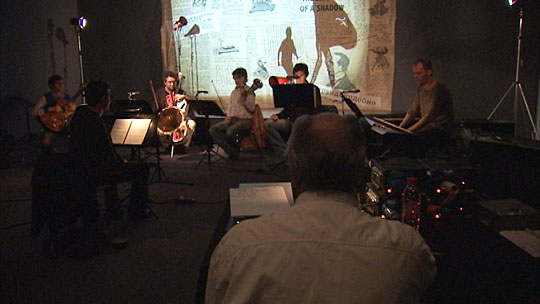
Rehearsals for an early version of I am not me, the horse is not mine at Marian Goodman Gallery, Paris, 2008. Production still. © Art21, Inc. 2008.
NR: I think a very good point about the limits of this sort of narrative documentary, particularly with artists, is that there’s a certain amount of room for differences within the artists’ work, within the documentary. There’s a certain point in which we hit a limit in our ability to tell a story. There’s nothing really constricting William. But constraining us is our own sense of how many different things you can look at, how many different things you can tell and still have it be about the same thing, the same artist.
EMO: The great challenge of documentary filmmaking is to extract, to get a person to say the things that are going to provide the context to have it make sense to an outside observer.
NR: Even if that person doesn’t want to.
EMO: Even if that person doesn’t want to. It’s that whole trick of getting one to repeat the question and the answer.
NR: But you’re talking about more than that. You’re talking about a different level.
EMO: Well that’s right, that’s a baby step towards it. You always have to put yourself in the position of the viewer who knows nothing. For one to just have a fragment of an explanation is sometimes too confusing to add up to a story with any meaningful takeaway. There was so much to talk about with William’s work. There was already enough challenge to both delve into the background and yet get the words out of his mouth that would make the connection between The Nose and all the other work. That’s a big challenge.
Excerpt from William Kentridge: Anything Is Possible, 2010
NR: Well that was one of the big ones actually. Sometimes, the artists themselves don’t always want to play your game. In the film, William says something like, “well in the hierarchy of the arts, the opera is always the most important thing. The opera is where you land up. And so you make drawings and you make visual work, then you do a musical, then all that gets synthesized into this great big work at the end. You take a bow.” He upends that at one point and says, “well, maybe the opera was just actually a way to get me to get to this other place…”
EMO: …like a conceit or….
NR: Right. That I am not me, the horse is not mine is really where he wanted to wind up — these smaller scale performances certainly don’t have anywhere near the visibility and sort of cultural heft that an opera does.
EMO: Going back to the challenge of an hour-long film, Kentridge is both uniquely challenging and uniquely opportune because there is so much going on [in his work]. Everything is related and yet the arc isn’t this simple. Things don’t get tied up in neat bows. There’s a fragmentation to chunks of the film. You can’t necessarily ask William to draw a line that is totally direct between one project and another. It’s more that they’re all united by this investigation into process and seeing. I think it was just challenging to prioritize how to get him to talk about all of those things in such a way that we could impose an arc on the story. Certain things got left out in that process because there was only so much time and so much ability to talk. You can’t tell everything in an hour. And you don’t want to. I think you want people to want more.



